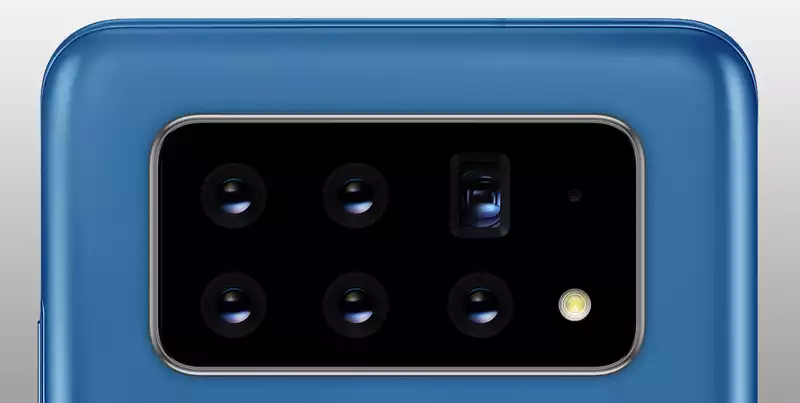Samsung's Galaxy S30 will likely compete with the iPhone 12, but a new weapon could give it a pretty big advantage. A newly discovered design by the Korean firm points to the possibility that the S30 could have a whopping six cameras and an array of sensors that can be moved and tilted individually.
This is based on a patent made by Samsung and discovered by LetsGoDigital titled "Apparatus and Method for Operating Multiple Cameras for Digital Photography." LGD has independently rendered this design and illustration of this camera setup to better understand how it works.
With some exceptions, such as the Nokia 9 PureView, most smartphones currently have up to four rear cameras. However, with so many cameras, it becomes difficult to fit all the sensors on the back of the phone. In the case of this patent, Samsung seems to have aimed for a horizontal camera bump like the one used in the Galaxy S10 series, but with twice the number and height of sensors. We can't say this is a good look; it's just not a good look.
The cameras themselves are five wide angle cameras, all with the same or one higher resolution "master" sensor, and one telephoto camera. Besides the sheer number of cameras, these sensors are unique in that they can be tilted within the housing, creating a unique effect.
For example, by placing the sensors on both sides in opposing directions, it is possible to create what the patent describes as "panoboke," a panoramic photo with a blurred background, or other photographic effects not possible with current cell phones.
More generally, cameras can be linked together to create more focused, higher-resolution images and higher frame-rate video for capturing fast-moving objects. This could prove more versatile than a single sensor with comparable resolution.
The depth of the camera bump is quite large, but there are good reasons for this as well. The patent also outlines a pop-out mechanism that allows the camera to be moved in and out of the body of the phone. This would not only make it easier to store, but would also allow the focal length of the sensor to be changed, which would help with focus and zoom.
Samsung has a bit of history when it comes to adding mechanical components to its cameras; both the Galaxy S9 and Galaxy S10 had variable apertures attached to the main sensor. But now Samsung is taking a strategy of using the largest camera sensors in its cameras, like the Galaxy S20 Ultra's 108MP main sensor.
This patent suggests (pardon the pun) that the company is more focused on adding new features than on increasing pixel count. Because the higher the resolution of the sensor, the less it yields.
Apple has avoided the megapixel race with the iPhone camera and stuck with a decent 12MP for several years while making other upgrades. It worked, and the iPhone 11 Pro is now one of the best camera phones along with the Galaxy S20. iPhone 12 will not be much different, except that the iPhone 12 Pro will have a LiDAR depth sensor and 3x telephoto zoom.
But we may have to wait a bit. The camera array of the upcoming Galaxy Note 20 follows the Galaxy S20 series, and the Note 20 Plus/Ultra will reportedly add a dedicated focus sensor. Thus, the earliest we will see the camera array described in this patent would be the Galaxy S30 in 2021. However, given that another rumor suggests that the S30 may have a 150MP camera, Samsung may not be done pursuing the highest resolution yet.










Comments